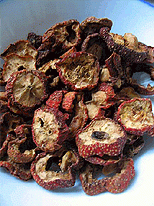Fructus Cartaegi
- Name
- Origin
- Where Does It Grow?
- Nature and Flavor
- Identified Active Components / Major Chemical Constituents
- Drug Actions in TCM
- Traditional Uses in TCM
- Pharmacological Actions
- Toxicology
- Administration and Dosage
- Adverse Effect, Side Effects and Cautions
- References
Name

Latin Name: Fructus Cartaegi
Common Name: Hawthorn fruit
Scientific Name: Crataegus pinnatifida Bge. / C. pinnatifida Bge. var. major N. E. Br.
Chinese Name: 山楂
Pinyin Name: shan zha
Origin
Fruit of Crataegus pinnatifida Bge. or C. pinnatifida Bge. var. major N. E. Br., the deciduous shrub or short arbor plants of the Rosaceae family.
Where Does It Grow?
The plant can be found throughout most of China, it is mainly produced in provinces such as Hebei, Shandong, Liaoning and Henan.
Nature and Flavor
Hawthorn fruit is sour and sweet in flavors, slightly warm in nature, and mainly manifests its therapeutic actions in the spleen, stomach and liver meridians.Identified Active Components / Major Chemical Constituents
Major active components in hawthorn fruit are organic acids, flavonoids, tannins, amino acids and multiple trace elements. The organic acids include cratagic acid, ursolic acid, citric acid, succinic acid, malic acid, chlorogenic acid, caffeic acid, oleanolic acid, palmitic acid and pyrogallol. The flavonoids include quercetin, vitexin, hyperroside and rutin. The fruit also contains epicatechin, flavan polymers, lipase, vitamin C and riboflavin, etc.Drug Actions in TCM
Hawthron fruit enhances digestion, relieves food retention, promotes qi (vital energy) circulation and removes blood stasis.Traditional Uses in TCM
Pharmacological Actions
Review
Clinical study
Animal study
Animal study
Toxicology
Administration and Dosage
For decoction, 10-15g each time, the dose can increase to 30g if necessary. Charred hawthron fruit is used when treating diarrhea conditions.
Adverse Effect, Side Effects and Cautions
Hawthron fruit is not recommended for individuals with peptic ulcers. For those who have a weak digestive system and without food retention, hawthorn fruit should be given with caution.References
- Lui Daiquan (editor-in-chief), Chinese Herbal Medicine, Shanghai Scientific and Technical Publishers, 2000-6.
- Zhao Zhongzhen & Xiao Peigen (editor-in-chief), Contemporary Medicinal Herbal Glossary, Hong Kong Jockey Club Institute of Chinese Medicine, 2006-8.
- Tao Yufeng, Clinical Herbal Medicine, People’s Medical Publishing House, 2005-5.
- Chen J, Chen T, ed. Chinese Medical Herbology and Pharmacology, Art of Medicine Press, 2004.
- Liu Ganzhong, Xu Qiuping & Wang Tai (editor-in-chief), The Essentials of Traditional Chinese Herbal Medicine, Foreign Languages Press, Beijing, 2003.
- Chang WT, et al. Hawthorn: potential roles in cardiovascular disease. Am J Chin Med. 2005; 33(1): 1-10.
- Walker, AF, et al. Promising hypotensive effect of hawthorn extract: a randomized double-blind pilot study of mild, essential hypertension. Phytotherapy Res 2002; 16: 48-54.
- Yeh C.H., et al. Effect of ShanZha, a Chinese herbal product, on obesity and dyslipidemia in hamsters receiving high-fat diet. Journal of Ethnopharmacology.
- 林科, 等. 山楂熊果酸的製備及對小鼠免疫功能和肝癌細胞凋亡的影響. 中國生化藥物雜誌, 2007; 28(5): 308-311.


